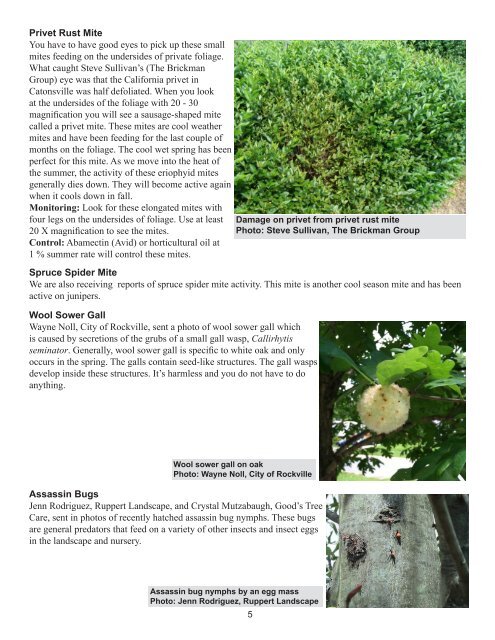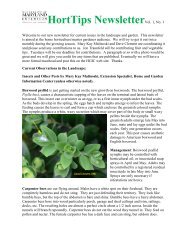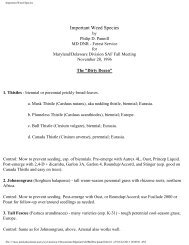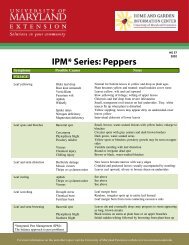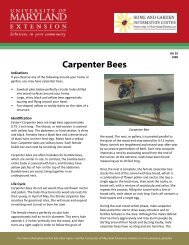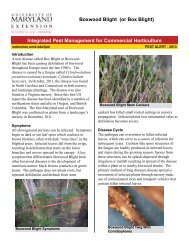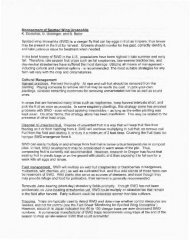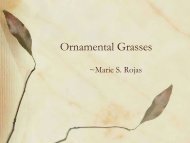13Jun07 - University of Maryland Extension
13Jun07 - University of Maryland Extension
13Jun07 - University of Maryland Extension
Create successful ePaper yourself
Turn your PDF publications into a flip-book with our unique Google optimized e-Paper software.
Privet Rust Mite<br />
You have to have good eyes to pick up these small<br />
mites feeding on the undersides <strong>of</strong> private foliage.<br />
What caught Steve Sullivan’s (The Brickman<br />
Group) eye was that the California privet in<br />
Catonsville was half defoliated. When you look<br />
at the undersides <strong>of</strong> the foliage with 20 - 30<br />
magnification you will see a sausage-shaped mite<br />
called a privet mite. These mites are cool weather<br />
mites and have been feeding for the last couple <strong>of</strong><br />
months on the foliage. The cool wet spring has been<br />
perfect for this mite. As we move into the heat <strong>of</strong><br />
the summer, the activity <strong>of</strong> these eriophyid mites<br />
generally dies down. They will become active again<br />
when it cools down in fall.<br />
Monitoring: Look for these elongated mites with<br />
four legs on the undersides <strong>of</strong> foliage. Use at least<br />
20 X magnification to see the mites.<br />
Control: Abamectin (Avid) or horticultural oil at<br />
1 % summer rate will control these mites.<br />
Damage on privet from privet rust mite<br />
Photo: Steve Sullivan, The Brickman Group<br />
Spruce Spider Mite<br />
We are also receiving reports <strong>of</strong> spruce spider mite activity. This mite is another cool season mite and has been<br />
active on junipers.<br />
Wool Sower Gall<br />
Wayne Noll, City <strong>of</strong> Rockville, sent a photo <strong>of</strong> wool sower gall which<br />
is caused by secretions <strong>of</strong> the grubs <strong>of</strong> a small gall wasp, Callirhytis<br />
seminator. Generally, wool sower gall is specific to white oak and only<br />
occurs in the spring. The galls contain seed-like structures. The gall wasps<br />
develop inside these structures. It’s harmless and you do not have to do<br />
anything.<br />
Wool sower gall on oak<br />
Photo: Wayne Noll, City <strong>of</strong> Rockville<br />
Assassin Bugs<br />
Jenn Rodriguez, Ruppert Landscape, and Crystal Mutzabaugh, Good’s Tree<br />
Care, sent in photos <strong>of</strong> recently hatched assassin bug nymphs. These bugs<br />
are general predators that feed on a variety <strong>of</strong> other insects and insect eggs<br />
in the landscape and nursery.<br />
Assassin bug nymphs by an egg mass<br />
Photo: Jenn Rodriguez, Ruppert Landscape<br />
5


